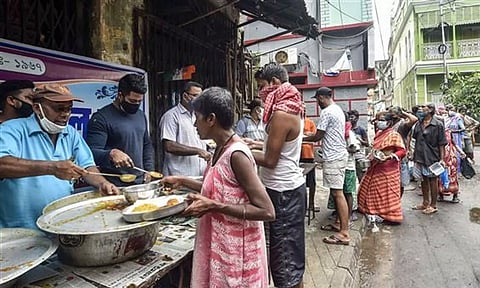

NEW DELHI: Out of a total of 125 countries in the Global Hunger Index (GHI) 2023, India ranked 111, with its battle against hunger almost coming to a standstill since 2015, which is in line with global trends.
The Centre contested India’s poor performance for the third year in a row, on account of flawed methodology. Last year, the country was ranked 107 out of 121 with a score of 29.1, and it trailed Nigeria (103) and Pakistan (99).
This year, India’s score was 28.7, and it was trailed by Afghanistan, Haiti, and 12 sub-Saharan countries. The GHI takes into account a 100-point scale where zero is the best score (no hunger) while 100 is the worst.
India’s severity of hunger has been categorised as serious, per the GHI which relies on a formula combining four indicators that represent the multidimensional nature of hunger. These include — under-nourishment (16.6/% for India), child stunting (35%, the 15th highest among countries in the list), child wasting (18.7%, the highest in the list) and under-five child mortality (3.1%). It’s ironic as India is a major food producer with extensive food security schemes as well as the largest public distribution system (PDS) in the world. Yet, we are home to as many as 224.3 mn undernourished people.
India is currently facing accelerating food price inflation. In July this year, annual inflation breached 11%, the highest in a decade. A report called the State of Food Security and Nutrition in the World compiled by the Food and Agricultural Organization (FAO) estimated that about 74% (1 bn people) of India’s 1.4 bn population cannot afford a healthy diet. In Mumbai, the cost of preparing a vegetarian thaali at home has gone up 65% between 2018-2023. During this period, the average wage of a manual labourer has risen by 38% and that of a salaried individual has gone up by 28%. The resulting hit in purchasing power obviously impacts food consumption too.
It’s noteworthy that no National Sample Survey (NSS) round on nutritional intake has been conducted by the Centre since 2011-12, an exercise that used to offer insights into the prevalence of calorie undernourishment at national and sub-national levels. So what is the government doing? The Food Safety and Security Authority of India – FSSAI has initiated the Eat Right India movement as one of its flagship programmes. There’s also the National Nutrition Mission as well as the PM Matru Vandana Yojana, a maternity benefits programme that offers cash benefits to pregnant women.
The National Food Security Act (NFSA) 2013 covers two-thirds of the population with subsidised food grains (75% of rural and 50% of urban families get 35 kg of grain per month at just Rs 2-3/kg). In Tamil Nadu, 35 kg of rice is offered free every month, bolstered by nutritious free meals for children in government schools. Still, millions fall through the cracks.
Dealing with food inflation will require the country to switch to mission mode, having seen how procurement prices, cash transfers, the PDS system and priority lending from PSBs are falling short in many ways. India needs contextualised policy and programmatic interventions to direct efforts to the communities that need it the most. A second agricultural revolution could herald equitable, sustainable, and resilient food systems for years to come.